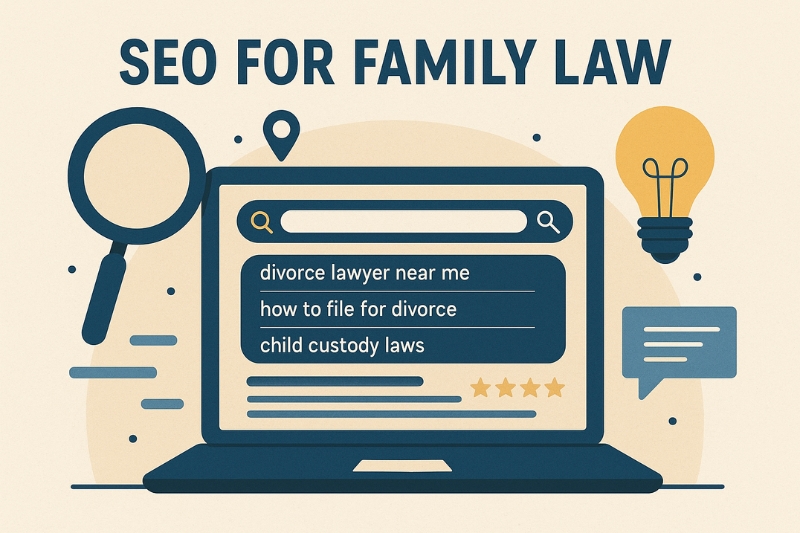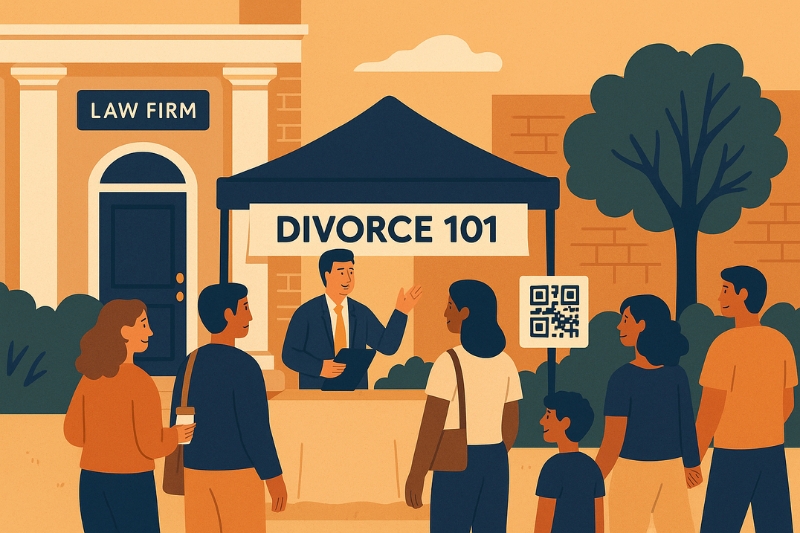Divorce, custody disputes, and domestic violence. Family law clients don’t come to you on a good day. They come at their most vulnerable, looking for answers and reassurance. That’s why marketing a family law firm is unlike marketing anything else.
You’re not exactly selling shoes or software. You’re showing people they can trust their lives to you. In this space, content is the first impression that decides whether a stranger picks up the phone, schedules a consult, or keeps looking elsewhere. Do it right and you’ll give them confidence before you ever shake hands.
But how do you make that happen? What does it look like in practice? And how do you know which parts of your law firm’s marketing efforts are really working versus the ones just wasting money? Keep reading to find out!
Key takeaways
- Trust is the real “sale.” In family law, a content marketing strategy can’t involve hard sells. Its purpose is to build confidence and empathy before the consultation.
- SEO is a must. Long-tail, local keywords, and a good Google Business Profile make your firm discoverable when clients need you most.
- Content is proof. Blogs, videos, and guides that answer real-life questions help you be seen as the safe, knowledgeable choice.
- Ads should amplify, not replace. PPC, Local Services Ads, and social retargeting work best when used alongside reviews and SEO.
- Measure what’s important. Track consultations, not vanity clicks, and reinvest in the channels that have proven to bring qualified family law firm clients.
Why family law content marketing isn’t like any other niche

Most marketing advice comes from the assumption that the buyer is excited, curious, and (hopefully) even impulsive. That’s not your client, though. A family law client is usually the opposite: exhausted, overwhelmed, and unsure about their decision. They don’t want a sales pitch. They want peace of mind, honesty, and some sign that you understand what they’re going through.
This is where family law marketing diverges from nearly every other niche. For example, in e-commerce, success comes down to discounts, cool product photos, and fast checkout. SaaS marketing boils down to feature comparisons, onboarding flows, and churn reduction. In those worlds, once the customer pays, the deal is done.
Family law couldn’t be further from that. The “sale” isn’t a consultation fee, but trust. Before someone lets you handle their divorce or custody case, they have to believe you’ll listen, protect their interests, and help them through uncertainty. Every blog post, testimonial, or video you publish is less about lead generation and more about building a bridge between a worried parent or spouse and your practice.
That’s why pushy copy and over-promises usually backfire here. A banner saying “Hire the #1 Divorce Lawyer Today!” comes across as cold and transactional. Conversely, an article explaining what to expect in a custody hearing feels more human. One makes people click away. The other makes them breathe easier.
As we move forward, remember this: in family law, content marketing isn’t a megaphone; it’s a soothing hand on someone’s shoulder.
Building trust before you ever meet the client

In family law, the first obstacle is on a personal level. Before anyone schedules a consultation, they’re likely asking themselves a more subtle question: Do I trust this person enough to tell them everything about my life? That’s why good marketing practices aren’t flashy ads but small, human touches.
Client testimonials are a perfect example. The ones that work don’t gush about “winning my case.” They talk about communication: how quickly you called back, how clearly you explained options, how you made them feel heard. That’s what a nervous parent or spouse is looking for.
The same principle applies to your website. A page on custody or spousal support that reads like a statute book will send people running. But if you have a page that breaks down timelines, outcomes, and common questions in plain English, you’ll achieve the opposite. It makes you approachable, someone who can take something complex and make it understandable.
Attorney bios are more important than most firms give them credit. You don’t need a wall of credentials that feels sterile anyway. You can have a short video introduction or even a few lines about why you practice family law gives visitors a reason to connect and get much more from it. Clients don’t hire a firm logo, they hire people.
Trust starts long before the handshake. And when it’s integrated well into your content, clients sense it immediately.
SEO is the backbone of discovery

What use is the most empathetic website in the world if nobody finds it? None. That’s why search engine optimization is such an important part of growth for family law firms. Like in any other business, it helps them show up exactly when someone types “divorce lawyer near me” or “what are the child custody laws in [city].”
So, how do you make it work? Let’s take a look…
Keyword intent that converts
Broad terms like “family lawyer” bring in a mix of people: some researching, some just curious, and a few ready to act. A much better yield comes from long-tail searches related to intent:
- “Child custody lawyer in Dallas”
- “How to file for divorce in Illinois”
- “Visitation rights for fathers in Philadelphia”
These searches aren’t just casual because they’re typed by people already in the thick of it: parents, spouses, and everyone else who needs help now. Ranking here means fewer tire-kickers and more qualified inquiries.
Local SEO that actually moves the needle
Family law is hyperlocal. People don’t want the best lawyer in the state; they want the best lawyer within 15 miles. Local SEO is how you win that search radius:
- A fully optimized Google Business Profile with accurate hours, legal services, and photos.
- NAP consistency (Name, Address, Phone) across directories like Avvo, Martindale, and FindLaw.
- A steady cadence of new photos, posts, and, most importantly, reviews. Google’s local search engine rankings rely heavily on review velocity and quality.
If you spend some time doing it right, your profile will look alive, trusted, and worth calling.
Beyond the basics
Once the essentials are covered, make sure to familiarize yourself with the demands of SEO in 2025 because it’s more than a few optimized pages:
- Content hubs that group blog posts, FAQs, and guides around specific issues (custody, divorce timelines, domestic violence protections). Think of them as mini resource centers that keep visitors engaged and show topical authority to Google.
- Mobile-first performance, because most searches happen on phones during stressful moments. If your site is a drag to navigate, people will give up.
- Voice-style queries optimized for natural language, like “Can I get full custody if I don’t have a job?”—not just stiff legal phrasing.
- Credible backlinks from local organizations, bar associations, or even coverage in community news. Having these links validates your authority in the eyes of search engines.
- Visible E-E-A-T signals (Experience, Expertise, Authority, Trust): attorney bios with credentials, cited sources in blog posts, and clear privacy and accessibility policies.
When all of this comes together, SEO for family law stops being a buzzword. It becomes the foundation of discovery and the reason a stressed-out parent searching late at night finds your firm, not your competitor’s.
Paid advertising without wasting your budget

SEO can get the ball rolling, but sometimes you need leads right now. Here’s where paid advertising can make sense, if you spend wisely.
Google PPC has been the standard for years across most industries. You bid on relevant keywords like “divorce lawyer near me” and pay each time someone clicks. If you set it up right, it puts you at the very top of search results, but click costs can add up quickly in competitive markets.
Local Services Ads (LSAs) are a different kind of deal. You’re not paying per click, but instead per lead. They also carry the green “Google Screened” badge, which gives credibility. For a lot of family law firms, LSAs deliver better ROI because you’re investing in actual conversations, not just traffic.
Social ads (Facebook or Instagram) can also be useful, but they’re most effective for retargeting people who have already visited your site or for reaching very specific demographics. You can target by age, marital status, or even life events like recently engaged or recently moved.
The common mistake is treating ads like a silver bullet. Spending broadly without a good landing page strategy is just lighting money on fire. If your ad promises a free consultation but your landing page buries the phone number, you’ll pay for clicks that never convert.
If you want to use paid ads, think of them as fuel poured on a fire that’s already burning. They work best if combined with good SEO practices, reviews, and a trustworthy family law firm website. Without that, you’re paying to send people into a leaky bucket.
Content that makes you the trusted voice

Anyone can run an ad. What sets the best family law firms apart is the content they leave behind: the articles, videos, and guides that keep working long after you hit “publish.” This is how you stop being just another option on Google and start becoming the firm people feel comfortable trusting.
Blogging that answers what people actually ask
The biggest mistake law firms make is writing for themselves instead of their target audience. Nobody types “comprehensive overview of equitable distribution statutes” into Google. They type:
- “How long does a divorce take in Florida?”
- “Do fathers ever get full custody?”
- “What counts as domestic violence in Texas?”
Posts that address these exact concerns become evergreen traffic drivers. The best ones go beyond surface-level definitions. They show what realistic timelines look like, common pitfalls, and what clients should expect in plain language. Tie those posts back to practice area pages with internal links, and you’ll get a blog that is a direct pathway to scheduling a consultation.
Video & multimedia
Sometimes words aren’t enough. A two-minute face-to-camera video explaining what happens at a custody hearing can feel like a personal consultation. Walk-throughs of processes like what to bring to mediation and how spousal support is calculated, provide clarity when people need it most. Infographics work just as well: flowcharts that explain divorce steps or visual checklists for custody filings. These formats are more digestible and more shareable, which increases your reach on social media platforms and even beyond.
Downloadables & guides
Not everyone who visits your site is ready to pick up the phone. Downloadable resources help bridge the gap between curiosity and commitment:
- A checklist for “The First 30 Days of Separation”
- A worksheet to prepare for a custody hearing
- A plain-language guide to spousal support basics
Give them in exchange for an email address, then follow up with supportive, relevant messages. Even if these feel like gimmicks at first, that goodwill carries over when the client finally decides to act.
Podcasting & webinars
Longer-form formats are the best way to build deep authority. If you can invest the time into deep dives into custody myths or co-parenting strategies, that alone can position you as both expert and ally. Webinars work even better when they’re co-hosted with mediators, therapists, or financial planners, because you’re embedding yourself into the larger ecosystem of family support. Clips from these sessions can be repurposed into short videos, blog recaps, or social posts, stretching the value even further.
It is time-consuming, but this kind of content transforms you from being a name on a search result to being the trusted voice in your community.
Social media as your reputation amplifier

As we’ve mentioned, family law isn’t the kind of service people impulse-buy on Instagram. But that doesn’t mean social media isn’t important. Prospective clients will check your profiles before calling, if only to see whether you look approachable and active.
The tone here is everything. Compassion beats bravado. Share practical tips, short myth-busting posts (“No, mothers don’t automatically get custody”), or quick Q&As filmed on your phone. Even behind-the-scenes snapshots, like your team volunteering locally, a family law attorney explaining why they practice family law, make your firm look more authentic.
How you respond brings more implications. A quick and compassionate reply to a comment or DM can work in your favor when someone is choosing between you and a competitor. That doesn’t mean you should provide legal advice in your inbox for free. Keep a system for triaging messages and route anything serious into your intake process.
Handled right, social media isn’t a direct lead generator, but it is proof that you’re accessible, engaged, and that you understand the values potential clients are looking for in a lawyer they can trust.
Community presence meets digital presence

For family law firms, showing up in the community like hosting a “Divorce 101” workshop at the library, sponsoring a school event, or co-presenting with local therapists, helps you get the trust you can’t buy with ads. People remember the lawyer they met at the PTA night more than the one they found by scrolling on Google.
But the mistake many firms make is treating these events as one-offs. To make them have an impact, always route offline visibility back to your digital presence. You can use a QR code leading to a dedicated landing page or a same-day recap posted on your blog and shared to social and then use retargeting campaigns aimed at attendees who visited the page.
With the right execution, community engagement creates searchable proof. When someone Googles you later, they see not just a law firm, but a name already connected to their local world. That recognition makes every click more likely to turn into a call.
Measuring what’s important

Family law marketing only works if you know what’s bringing constant results. Way too often, firms measure success in website traffic or Facebook likes, which are metrics that feel good but don’t tell you if they actually convert into calls.
But you don’t need a complicated tech stack. A simpler setup does the job just as good:
- Google Analytics 4 for website behavior.
- Search Console for keyword rankings and visibility.
- Call tracking software to track phone leads back to campaigns.
The point is quality over quantity. If paid ads are generating clicks but no consultations, the problem might be your landing page or your call-to-action. If blog posts are generating tons of traffic but no conversions, it could be time to adjust topics or CTAs.
The metric that matters most is cost per consultation, not cost per click. Reallocate budget into methods that bring in booked consults, even if they don’t look too fancy on paper. In family law, efficiency is less about volume and more about connecting with the right people at the moment they’re ready to act.
Conclusion
Content marketing for family law firms is a system that compounds. The blogs you write this month, the reviews you collect this quarter, and the resource pages you publish today will be dictating how people find and judge your firm a year from now.
If you’re looking ahead, think about how the same content you create for search can feed into emails, social posts, or even community workshops. That’s when you’ll stop viewing your marketing strategy as a cost and start seeing it like an asset that keeps working in the background while you focus on helping people.

